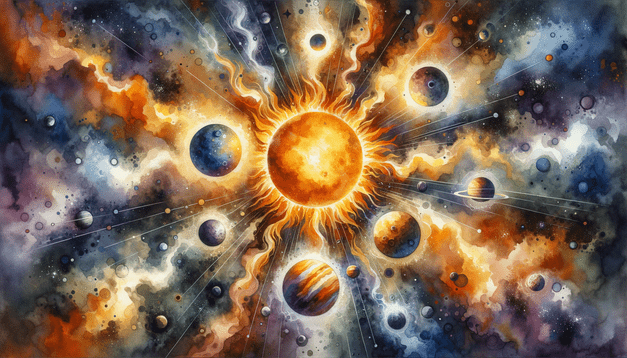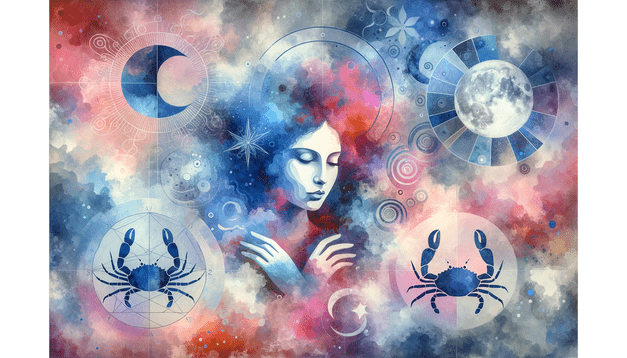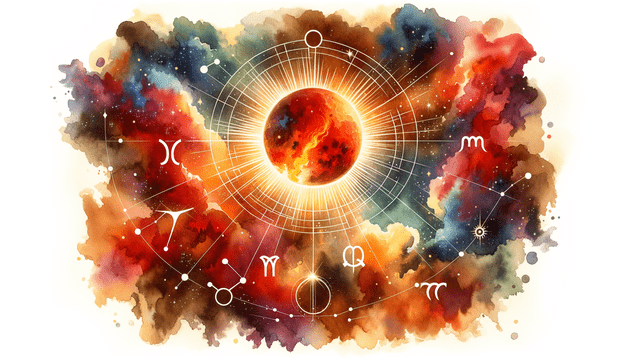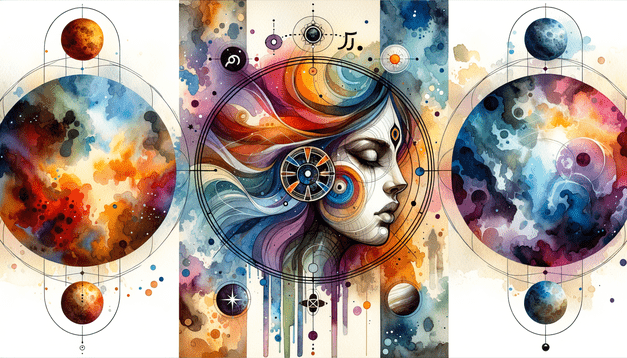Aspects
When it comes to astrological interpretations of any kind, understanding the importance of aspects and their place in our approach is vital for any reading. Without them, we can only sense an atmosphere or recognize certain characteristics of an individual, but we cannot understand the relationships they have in their life, relationships between their parents, and emotional bonds that define them. If you think of your natal chart as a graphic presentation of your DNA, we can see that aspects are similar to bonds between two DNA strands. Without them, no story would be connected and you wouldn’t get the image of relating that seems to be vital for our existence on planet Earth.
Definition
An aspect represents one of the specific angles that projections of different celestial bodies, house cusps, or imaginary points form in a zodiacal circle. Their main role is to give dynamism to our chart, representing relationships between different entities and showing the flow of time through orbs and planetary speed. Each aspect is a view, a point of perspective, and the way one celestial body observes the other. If an aspect is positive and easy, energy will flow, and we will see the entities involved giving each other a beneficent glance, looking at each other with love, admiration, or simply support and acceptance. Tension seen through challenging aspects can only be overcome by raising awareness and realizing that additional energy is needed to fix what is broken, or mend wounds left to our inheritance.
If we observe each celestial body as a person with a certain role in our lives, we will see that its position in a sign represents the role itself, the house it is in represents location or the area of life where they will show up and manifest, and aspects represent the relationships they made. Depending on the role we decide to take ourselves, we will see that the greatest polarization with other people comes from jumping into squaring or opposing positions in our charts.
Keep in mind that there is no such thing as a “perfect moment in time” when all planets will line up to show perfection of the energy flow. We wouldn’t be here, on planet Earth, if there wasn’t something we need to learn on our path to enlightenment, and challenges are the pathway towards it. Although easygoing people with many positive aspects in their chart have enough ease and clarity in their lives, they will often lack that strong inner push of motivation and the need to fight for new achievements if they don’t have any challenges to resolve. This is why we see so many people with “good charts” failing to accomplish anything great in their lives, while those challenged most tend to use this uncontrolled energy of their problems, and point it in a direction that makes them happy. On our path to happiness, those of us that have to fight for satisfaction often jump one step further than those who were already born a bit happier, and we all have our important roles in the greater order of things.
Ptolemaic Aspects
Modern Astrology acknowledges numerous angular relations as minor aspects, but we have to separate the ones with a long tradition and a basic role in every interpretation from those with less noticeable manifestations. Known as “Ptolemaic Aspects”, these main five relationships in one’s chart are seen as angles of 0, 60, 90, 120 and 180 degrees. Some astrologers take the 30° and 150° relations to be almost as important as the rest of these, for they seem to represent two missing points in 30-by-30 division of the circle. Still, main aspects seen through traditional Astrology and defined by Ptolemy are always the following:
Conjunction
A conjunction is an aspect of 0 degrees, with an allowed orb of up to 17 degrees if the Sun is involved. It speaks of one’s Self and has both positive and negative connotations, depending on the nature of entities involved in it. In case there is a malefic pressing on another planet, especially if its dignity is low, we will see the conjunction as challenging for this planet. On the other hand, if a beneficent planet is a part of conjunction, it will be observed as a supporting aspect, especially for a malefic in conjunction with the supporting planet.
We have to keep in mind that there is no such thing as “positive and negative planets.” The only problem that creates a challenge is our human perspective and the way we observe them. So Saturn is maleficent from our point of view, dark and pressuring us from the shadows, but this is just a part of human nature that pushes us to avoid taking responsibility, having trouble dealing with unconscious energies we’d rather dismiss. In its most positive glow, Saturn is our deepest faith, our relation to God and our ability to take our lives into our hands, being a grownup, capable, strong, with clearly set boundaries. In a similar way, one’s Venus can be kind, loving and beautiful, or in a way maleficent, turning us to gluttony, laziness or adultery. It is all a matter of perception.
A special case of a conjunction we need to be aware of is called the Cazimi conjunction, and it is only possible with the Sun. It is an exact conjunction that falls into the orb of no more than 16 minutes, and the planet that comes this close to the Sun is said to be “in the heart of the Sun” or “in the heart of the King.” This is a position that speaks of a blessing for the planet in question, as it is protected by the greatest deity - the star that gives us life. It always points to someone “in God’s mercy”, a protégé and a favorite person of someone in a high position. Up to 8 degrees distance from the Sun, all other conjunctions with it will leave a planet in its “shadow” and burnt, traditionally seen as combust.
Opposition
Opposing entities form an aspect of 180 degrees, and this puts them on two furthest points in the zodiacal circle. Each opposition is speaking of “The Others” and of tension and the challenge of accepting differences we have with other people. It shows through the nature of Uranus as a need to break loose, separate, divide the world and everyone in it into “good and bad”, while seeing things in black and white. The main challenge of the opposition is to accept that entirely different things have a shared common point, and that each sign in the zodiac seems to simply mirror the one across from it.
Each opposition is common ground to see who we are in depth, and instead of shifting blame, searching for flaws in everyone else, and fighting with others to reach the point of freedom, we have to embrace our similarities and realize that what truly annoys us in other people represents our own weaknesses.
Sextile
A sextile is a 30 degree angle between celestial bodies. It is a supporting aspect with nature of Venus and this makes it easy to ground, manifest and enjoy, usually supporting us with love, gratitude and acceptance. This is an aspect of earthly pleasures and speaks of emotional connection as much as a physical one, so it gives a glimpse into a person’s relationship with their body and their physiology. This shouldn’t be missed in case of a challenging disposition where planets that were originally in sextile get carried away by their rulers to form a square or an opposition, for this could give self-destructive tendencies that aren’t seen at first glance.
Trine
A trine is a relation of 120 degrees between entities in a zodiacal circle. It is a supporting aspect with the nature of Jupiter, and this might make it hard to ground, but it gives protection, knowledge, calm, and perspective. Things in our lives that last are always seen through the vision and expectations of a trine and we will see that people with life-long friendships and lasting relationships have this atmosphere in their charts. No matter if beneficent or maleficent planets are involved in this aspect, they will protect us and show us the direction we need to take. This is the aspect of hope and beliefs, and has the ability to change our perspective through relationships with people who have the knowledge and width of mind to accept sides to us that we sometimes fail to recognize in their entirety.
Square
A square is a 90 degree angle formed by celestial bodies in one’s chart. It is a challenging aspect with the nature of Mars, bringing tension and anger into our lives. It is the aspect of “outer influences” that will break our boundaries and make us susceptible to change imposed on us by other people and circumstances out of our control. While oppositions have clarity in direct conflict and relationships that we can mend, squaring aspects seem to bend our energy and focus, letting too many unrecognizable and non-supporting things into our world. This is a typical aspect of meddling and side characters that take large roles in situations and relationships that aren’t theirs to judge or interfere with.
Minor Aspects
Minor aspects are aspects with less impact, usually interpreted only in modern Astrology and seen mostly through personality traits and supporting circumstances that don’t manifest as obviously as those seen through aspects presented above. These angular relations officially take 30 and 150 degree aspects into consideration, named Semi-Sextile and Quincunx (Inconjunct) respectively, and they will have the strongest impact of all minor aspects.
Quincunx is a relation that represents the natural orb between our first and eighth house and speaks of our shadows, things we have a hard time accepting, change, and in its most extreme manifestation – death. This makes it interesting and studied by many, but it is still of lower impact on our lives than Ptolemy aspects. Apart from them, we should be aware that a Semi-Square (45°) is something like a “small square” speaking of bickering and small misunderstandings, just like a Semi-Sextile speaks of those small supporting gestures that we often fail to notice.
To add to the list, other minor aspects are typically unordinary divisions of a full circle of 360 degrees, and so we will see that a Novile (Nonagen) is an angular relation of 40° (being one ninth of the whole circle), Quintile is an angular relation of 72° (one fifth of the whole circle), etc. While all of these, with added Septile, Vigintile, Decile, or any other minor aspect you encounter, do give a certain glow to the chart, there won’t always be room for such in-depth personal analysis, unless if we make them our primary research or interpreting direction.
Orbs
An orb is a distance from an exact aspect, this being a connection between entities with less than one degree to any of the angular relations described above. Even though there are limits to orbs and distances from exact contacts that can still be felt and taken into consideration, we will come to see that conflicts and support can be felt even if orbs are much larger than we would need them to be to recognize them as relevant.
For example, planets in the same sign, one being set on the first degree and the other on the last, will still have a lot to share. Even though their orb might be 29 degrees, and their conjunction isn’t even recognizable by permitted orbs except through a possible Semi-Sextile, they will still share the same ruler and be brought to disposition by the same celestial body. These planets will be in an obvious relationship even though it isn’t recognized as a typical conjunction. Similarly, planets in signs that form a natural trine understand each other well, even if they are in the orb of a square made from the preceding sign.
Minor aspects act on smaller orbs and we won’t see them active in a person’s life unless they are exact or very close to exact (up to a maximum of 2 degrees). On the other hand, Ptolemaic aspects will be sensed even if they are not considered aspects anymore, for shared or related elements or qualities of planets will make them see each other in a certain light. The Sun forms large conjunctions, shining a light far beyond the point where some distant planets will fade, and spreading up to 17 degrees of the zodiacal circle, sometimes even more. On the other hand, a planet such as Pluto, unseen with a naked eye, doesn’t act as strongly on orbs larger than several degrees. Depending on the aspect itself, we will see that sharing a sign in a conjunction, or an element with a trine, will have a larger possible orb and a greater impact than that of a Venusian sextile spreading on up 6 degrees of effective orbs in application.
We can define the influence of each aspect more or less precisely, but the purpose of our learning is to reach a point of relationship understanding so we can sense the strength with all of the roles involved. No aspect is the same and the manifestation of each and every one of them will depend on many different things, starting from the size of the celestial body, the light it emits, the type of aspect itself, the house each of the planets involved rule, of its imminence or passing effect, etc. If we want to understand “permitted orbs” our own understanding of each entity involved in them needs to be vast.
|
ASPECT |
PERMITTED ORB |
|
|
APPLICATION |
SEPARATION |
|
|
Conjunction |
10° |
8° |
|
Sextile |
6° |
4° |
|
Square |
8° |
6° |
|
Trine |
8° |
6° |
|
Opposition |
8° |
6° |
|
Minor Aspects |
2° |
1° |
Applying and Separating Aspects
The best way to see the importance of planetary movement is in the applying or separating nature of the aspect. It will not feel the same if a fast entity, for example – the Moon, approaches an aspect in the moment of birth, or if it has already formed it and now only carries its consequences further on. Applying aspects are aspects that are about to be made. Aspects that fade in time are separating aspects.
To understand this, we have to see the chart as a pulsating being, created in a specific moment when certain issues were relevant and passed just moments later. An approaching conjunction will have a strong impact on a person’s life, carrying the energy of constant collision and pulling us in its direction over and over again to repeat a pattern given to us by birth. On the other hand, once an aspect occurred, its passing atmosphere will make it fade through life and most separations will hardly be felt as we get older, if their disposition doesn’t pull us into the same loop of repetition.
Unaspected Planet
If we see a planet that has no close proximity to any aspect in a person’s chart, its role in their life can turn them to solitude, isolation, and lack of support and understanding from the outer world. In such a case, we are to observe the ruler of the planet and see the aspects it makes, for they will often hide below the surface and carry much more “off-the-grid” meaning than the primary position of the planet. Only in the case when this planet is located in the sign of its own rule (for example if Venus makes no aspects in Taurus), can we presume that it is its destiny to discover itself through solitude, and channeling all that a given sign has to offer on its own. When this occurs, it is a signal that additional attention should be sent in its direction so we can relate to this side of our personality, instead of neglecting it and letting it sink into oblivion.
Void of Course Moon
When the Moon passes the last aspect on its path through a sign, we say it is void of course. If we find it in such a state in one’s natal chart, it will implicate that their Soul is in search for solitude and inner recognition, in a way similar to a balsamic Moon that ends one cycle only to prepare for the new one. This is a position that speaks of loneliness as much as it speaks of experience, and the need for emotional recognition is strong and often pressing. The important thing here is to observe the Moon’s ruler and see if it takes the Moon to the new beginning or if this entire lifetime is an ode to cleansing and the discovery of the inner truth.
In general, we have to remember that this is the Moon that speaks of moments when “nothing happens”. When it is set this way in a person’s natal chart, it carries a deeply rooted message that “nothing happened” when they were born. Seen through this perspective, it can be a very lonely and depressing position that makes flowing emotional contact with other people almost impossible. To overcome its challenges, bravery will not be enough, and a person will have to work on specific family issues that led to this point. Facing times when they were neglected and embracing those who made them feel this way is the only forgiveness they need, so they can find freedom in the upcoming sign their natal Moon is about to visit.




